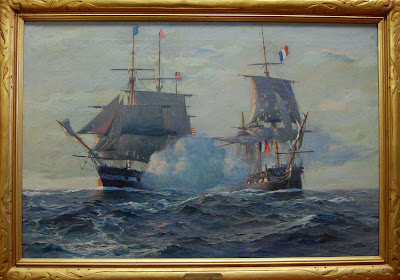Live War Game Demonstration: After Action Review
Thank you to everyone who joined us for last Friday’s live war game demonstration featuring the battle for Okinawa. If you were unable to watch in real time, follow this link to see a replay of the action:
This event brought together staff from the Naval War College Museum and the Puget Sound Navy Museum for a “friendly” game of Memoir ‘44, a popular boardgame depicting World War II battles. Since April 1 marked the 75th anniversary of the start of Operation ICEBERG, we decided to play a scenario that took place on Okinawa pitting the Marines against a dug in Japanese force defending the Shuri Line on the southern end of the island. Two prominent terrain features, Sugar Loaf and Half Moon, dominate the board in this scenario. Both consist of hills and caves that make the Japanese very difficult to dig out even in the face of a determined attack.
Fighting began in front of Sugar Loaf with the Americans firing from long range with their armor and artillery. The very first shot of the game reduced a Japanese unit by 75%, an excellent result for the Marines that also demonstrates the lethality of American firepower. At this point in the war, the Japanese Army could not hope to fight in open terrain against a superior enemy who enjoyed lavish naval, air, and artillery support. Its commanders adjusted their tactics to take advantage of the terrain and inflict disproportionate casualties on the combined Army-Marine force that made up Tenth Army, the unit assigned to secure Okinawa. That is exactly how it played out in our game too.
 |
| Opening shots |
After eliminating the first Japanese unit, the Marines in the center and right half of the board (representing the 6th Marine Division) rushed up to the western side of Sugar Loaf, hoping to catch the defenders unprepared. The Marine combat engineers got adjacent to one of the caves and used their advantage in close combat to destroy another Japanese unit, capturing the cave in the process. However, these engineers and the two supporting infantry units took so many casualties while advancing on Sugar Loaf that the resulting Japanese counter attacks eliminated all three units. This sequence in the game proved to be a faithful representation of historical events. The actual fight for Sugar Loaf lasted a week with the Marines capturing it several times, only to be thrown off by Japanese infantry hidden in positions on the reverse slope.
 |
| The Marines attack Sugar Loaf... |
 |
| ...and pay the price |
The infantry having exhausted themselves, it was now time for the American armor to attack. Two tank units approached Sugar Loaf and moved onto the hill complex, but the Japanese countered by taking advantage of this scenario’s special tunnel rules to move a unit from the right side of the board to one of the caves directly in front of the tanks. While tanks are a major threat to infantry in the open, they are decidedly less effective when trying to hit an enemy in good defensive terrain. Indeed, the tanks found themselves far out in front of their own lines with no friendly units nearby. The Japanese infantry made quick work of them.
Fighting now shifted over to Half Moon, the other major hill/cave complex on the board. The Americans played an Assault card to move up two regular infantry and one engineer unit, all with an eye toward attacking the lone Japanese unit on that side of the board. The Japanese reinforced with a second unit utilizing the tunnels, then attacked the engineers with a devastating dice roll that eliminated them and secured the victory.
 |
| The final shot |
Congratulations to the Puget Sound Navy Museum! You have bragging rights for now. Care for a rematch?


Comments
Post a Comment